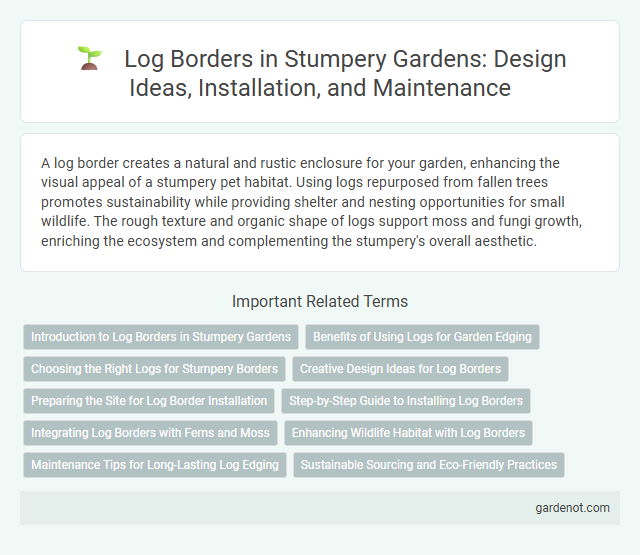A log border creates a natural and rustic enclosure for your garden, enhancing the visual appeal of a stumpery pet habitat. Using logs repurposed from fallen trees promotes sustainability while providing shelter and nesting opportunities for small wildlife. The rough texture and organic shape of logs support moss and fungi growth, enriching the ecosystem and complementing the stumpery's overall aesthetic.
Introduction to Log Borders in Stumpery Gardens
Log borders in stumpery gardens create natural, rustic edges that enhance the woodland aesthetic. These borders use decayed or moss-covered logs arranged to define planting areas while supporting biodiversity by providing shelter for insects and fungi. Integrating log borders promotes ecological balance and enriches the textured, organic design characteristic of stumperies.
Benefits of Using Logs for Garden Edging
Logs used for garden edging create a natural, rustic boundary that enhances the visual appeal of a stumpery, blending seamlessly with the woodpile aesthetics. These log borders provide durability and resistance to weather elements, ensuring long-lasting garden structure without frequent maintenance. Their natural decay process enriches soil quality, promoting healthier plant growth around the garden edges.
Choosing the Right Logs for Stumpery Borders
Selecting the right logs for stumpery borders involves prioritizing native hardwoods like oak, ash, or beech, which offer durability and natural resistance to decay. Logs should vary in size and texture to enhance the organic aesthetic and provide diverse habitats for wildlife such as insects and fungi. Properly aged, seasoned logs improve longevity and support the ecological balance within the stumpery environment.
Creative Design Ideas for Log Borders
Creative design ideas for log borders in stumperies include arranging logs in varied heights and angles to create dynamic visual interest and natural texture. Incorporating moss, ferns, or small flowering plants between the logs enhances the organic feel while promoting biodiversity. Using reclaimed wood logs with distinct bark patterns adds rustic charm and sustainability to the garden feature.
Preparing the Site for Log Border Installation
Clear the designated area by removing debris and leveling the soil to ensure proper drainage and stability for the log border. Mark the layout using stakes and string to maintain a precise and consistent border shape. Dig a shallow trench aligned with the marked perimeter to securely anchor the logs and prevent shifting over time.
Step-by-Step Guide to Installing Log Borders
Installing log borders for a stumpery enhances its rustic charm while controlling soil erosion and plant spread. Begin by selecting straight, durable logs, then dig a shallow trench along the desired border line, set the logs vertically or horizontally into the trench, and backfill with soil to secure them firmly. Regular maintenance includes checking for wood decay and repositioning logs to maintain an even, natural edge.
Integrating Log Borders with Ferns and Moss
Log borders create a naturalistic edge that enhances the visual appeal of stumperies by seamlessly integrating with ferns and moss. The rough texture and organic shapes of logs complement the delicate fronds of ferns and the soft, lush coverage of moss, creating a layered ecosystem that thrives in shaded, moist conditions. This combination supports biodiversity by providing habitat for insects and small amphibians while maintaining soil moisture and preventing erosion.
Enhancing Wildlife Habitat with Log Borders
Log borders create essential microhabitats by providing shelter and breeding grounds for insects, amphibians, and small mammals, significantly enhancing local biodiversity. These natural structures retain moisture, promote fungal growth, and support decomposer communities critical for soil health. Integrating log borders into garden design fosters a thriving ecosystem while offering natural pest control and contributing to conservation efforts.
Maintenance Tips for Long-Lasting Log Edging
Log borders in stumpery design require regular inspection to prevent rot and insect damage, ensuring longevity. Applying a wood preservative annually and keeping the logs elevated from direct soil contact reduces moisture exposure. Trimming surrounding vegetation promotes airflow around the logs, further extending the life of your log edging.
Sustainable Sourcing and Eco-Friendly Practices
Log borders in stumpery design emphasize sustainable sourcing by utilizing reclaimed or fallen wood, reducing the need for new timber harvesting and preserving natural habitats. Eco-friendly practices include selecting locally sourced logs to minimize carbon footprint and promoting biodiversity by providing habitats for insects and small wildlife. These methods support environmental stewardship while enhancing the natural aesthetic of the stumpery.
Log border Infographic

 gardenot.com
gardenot.com